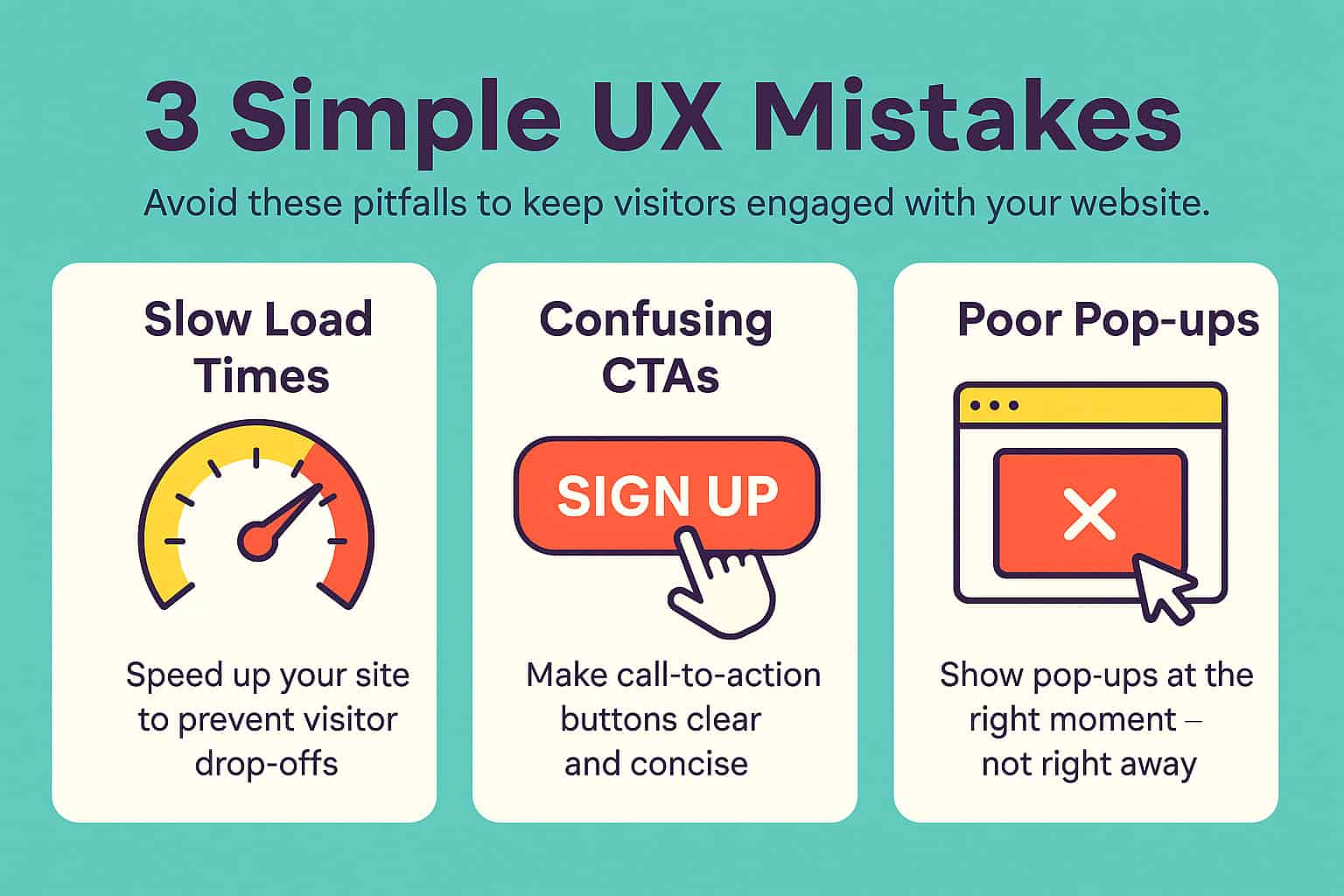Key Takeaways
If your website isn’t getting clicks or conversions, your engagement rate, not your bounce rate, is what really matters. Fix these three key areas:
- speed up your site to reduce visitor drop-offs,
- simplify confusing CTAs so users know what to do,
- and time your pop-ups carefully to avoid annoying your audience.
These quick wins can keep people engaged, and turn visits into results:
Slow Load Times Drive People Away: Users expect your site to load in under 3 seconds, speed matters more than ever for keeping visitors engaged.
Confusing CTAs Kill Conversions: Clear, well-placed calls-to-action help guide users and increase interaction, avoid vague or competing buttons.
Poorly Timed Pop-Ups Frustrate Users: Pop-ups can still work, but only if timed correctly and used sparingly, don’t interrupt your visitors too soon.
Focus on Engagement, Not Bounce: The majority of web surfing is mobile – Engagement rate gives more accurate insights than bounce rate, track what users do, not just when they leave.
Need help? Chat with us to learn how our WordPress hosting handles it all for you automatically.
When I talk to owners about results, the metric that always moves the needle is engagement rate, the clicks, scrolls, and interactions that show visitors are actually interested. Unlike the old-school “bounce rate,” which is skewed by mobile distractions (hello, Uber pickups and incoming calls, etc.), engagement rate measures what people do on your site, not why they leave. Below, I’ll show you how to raise that number fast by tackling slow load times, confusing calls-to-action, and mistimed pop-ups.

Slow Load Times: Speed Is the First Impression.
Recent UX studies show that 53% of mobile users leave if a page takes longer than three seconds to load, and they form a negative brand opinion after just a single slow visit. Add to that Google’s finding that a 400-millisecond delay, the time it takes to blink, can shift traffic to a faster competitor.
Quick Wins.
Action | Why it Works | DIY Tip |
ActionWhy It WorksDIY Tip Enable server-level caching (e.g., WP Rocket) | Delivers pre-built pages instead of regenerating them on each visit | Easy setup guides provided by developers |
Activate critical CSS / defer JS | Loads above-the-fold content first so visitors see something within 0.5s | PageSpeed “Remove render-blocking resources” filter |
Use a CDN edge network local to your city | Shrinks physical distance, the top speed bottleneck for neighbourhood searches | Cloudflare’s free tier is often enough |
Benchmark: Re-test your Largest Contentful Paint after each tweak. Aim for < 2.0 seconds mobile; under 1 second is “delightful.” This should be part of your regular monthly check-up routine.
Confusing CTAs: Too Many Choices, Not Enough Action.
A review of common CTA mistakes shows that the biggest killers are vague text (“Click Here”), too many CTA buttons, and buttons that blend into the background.
Best-practice checklist:
- Write outcome-driven copy: “Get My Free Quote Now” – not “Submit.”
- Differentiate primary vs. secondary CTAs: Use colour contrast and size hierarchy so visitors instantly spot the main action.
- Avoid paralysis of choice: Keep to one primary CTA per page; extras belong in the footer or after the scroll.
- Mobile thumb zone: Ensure the CTA is reachable without stretching on devices ≤ 6″.
Pop-Up Timing: Less Intrusion, More Conversion.
Pop-ups still lift conversions when they add value and respect timing, but instant, irrelevant pop-ups send visitors running.
Smart Pop-Up Rules.
Good Practice | Setting | Why it Converts |
Exit-intent or 30% scroll | Triggers only after user engagement | Catches readers who are already interested (not just landed) |
Relevance filter | Pop-up content matches the page topic | A discount on face cream shows up on a skin-care article, not a car insurance article |
Mobile-friendly size | Covers max 30% of the screen with a big “X” | Avoids Google’s intrusive-interstitial penalty and user frustration |
One pop-up per session | Frequency cap | Prevents “popup fatigue” and keeps bounce rates low |
Remember: value + timing + relevance = useful, not annoying.
Something to Keep in Mind About Pop-Ups on Your Website.
Pop-ups can be a helpful tool for capturing attention, but there’s an important caveat to consider. Many modern web browsers, especially those focused on privacy, like Brave or LibreWolf, are designed to block pop-ups by default. In fact, from my own experience, I haven’t seen a pop-up on a website in over five+ years (that I can remember).
Whether or not you personally like pop-ups (I’m not a fan myself), the key point is this: if you’re using pop-ups to promote a call to action (CTA), make sure that same message is also clearly included in the main content of your website. You can’t rely entirely on pop-ups, because there’s no guarantee every visitor is going to see them.
To ensure your message reaches as many people as possible, your CTA should always be part of your page content, not just tucked away in a pop-up.
Why Engagement Rate Beats Bounce Rate in 2025.
- Mobile reality: Users pause browsing for calls, transit stops, causing “false” bounces.
- Positive focus: Tracking clicks, scrolls, and time on page lets you double-down on what works.
- Actionable data: Heat maps and GA 4 engagement metrics show exactly where to optimise.
Three Fixes, Endless Upside
Speed up those pages, simplify your CTAs, and time pop-ups to serve (not scare) visitors. You’ll see an instant lift in your engagement rate, which translates to more leads, calls, and sales.
Need a hand compressing images, tuning pop-ups, or installing a faster theme?
👉 Chat with us now we’ll help optimise your WordPress site, boost engagement, and back everything up daily.
FAQs
What does “engagement rate” really mean for my website?
Engagement rate shows how visitors interact with your site, what they click, how far they scroll, or whether they take action like filling out a form. It helps you understand what’s working.
My website seems slow. How can I check what’s causing it?
Use free tools like Google PageSpeed Insights or GTmetrix. They’ll show you what’s slowing your site down and offer simple suggestions, even for non-techies.
I don’t know if my call-to-action (CTA) is clear. What should I look for?
Ask: is your button telling people exactly what they get? “Get My Free Estimate Now” is clearer than “Submit.” Also, avoid using too many buttons, stick to one clear action per page.
Are pop-ups still okay to use? Or do they just annoy people?
They’re okay, but only if timed well. A pop-up that appears after a visitor scrolls or starts to leave is much better than one that shows up immediately. Keep it small, relevant, and easy to close, especially on mobile.
Do I need to hire someone to fix my website’s engagement issues?
Not always. Many fixes like compressing images, adjusting CTA wording, or changing pop-up timing can be done by you or your team using WordPress plugins or built-in settings.
How do I know if my fixes are working?
Track your results using tools like Google Analytics or Microsoft Clarity. These tools show where people click, how long they stay, and what pages get attention. Focus on the positive—what’s increasing!

